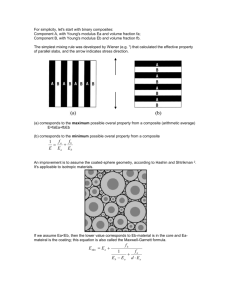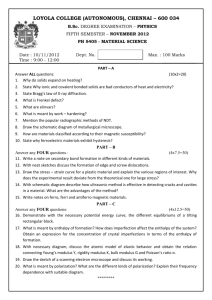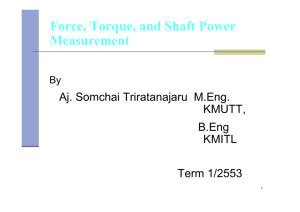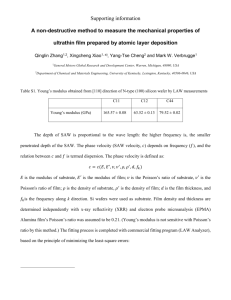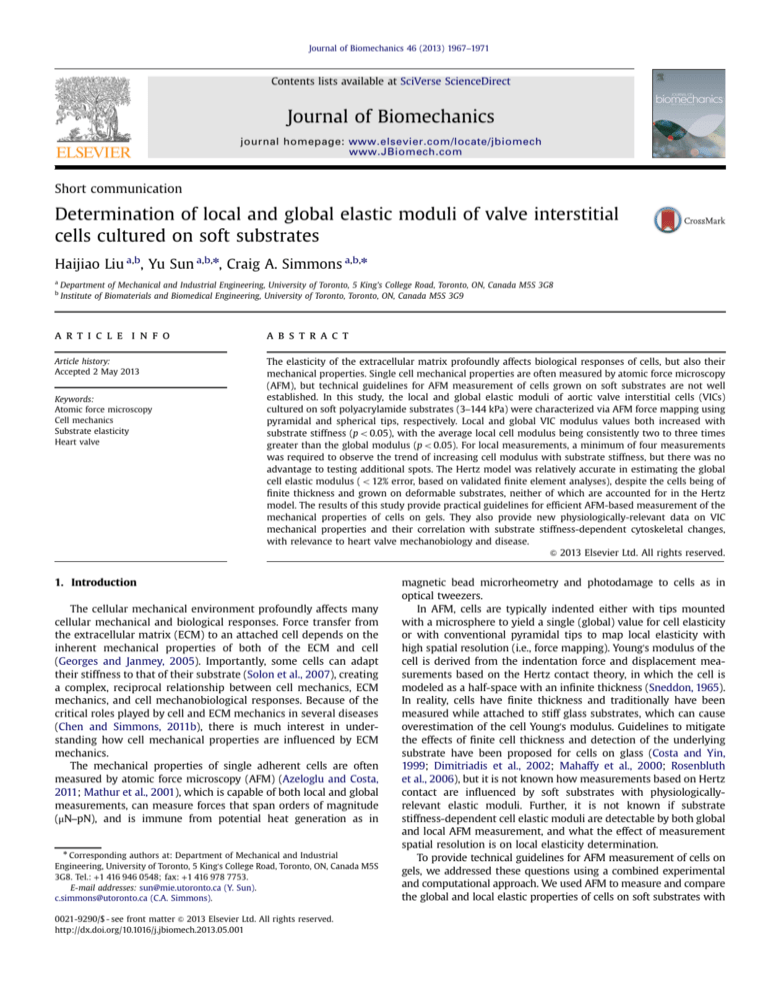
Journal of Biomechanics 46 (2013) 1967–1971
Contents lists available at SciVerse ScienceDirect
Journal of Biomechanics
journal homepage: www.elsevier.com/locate/jbiomech
www.JBiomech.com
Short communication
Determination of local and global elastic moduli of valve interstitial
cells cultured on soft substrates
Haijiao Liu a,b, Yu Sun a,b,n, Craig A. Simmons a,b,n
a
b
Department of Mechanical and Industrial Engineering, University of Toronto, 5 King’s College Road, Toronto, ON, Canada M5S 3G8
Institute of Biomaterials and Biomedical Engineering, University of Toronto, Toronto, ON, Canada M5S 3G9
art ic l e i nf o
a b s t r a c t
Article history:
Accepted 2 May 2013
The elasticity of the extracellular matrix profoundly affects biological responses of cells, but also their
mechanical properties. Single cell mechanical properties are often measured by atomic force microscopy
(AFM), but technical guidelines for AFM measurement of cells grown on soft substrates are not well
established. In this study, the local and global elastic moduli of aortic valve interstitial cells (VICs)
cultured on soft polyacrylamide substrates (3–144 kPa) were characterized via AFM force mapping using
pyramidal and spherical tips, respectively. Local and global VIC modulus values both increased with
substrate stiffness (po 0.05), with the average local cell modulus being consistently two to three times
greater than the global modulus (p o0.05). For local measurements, a minimum of four measurements
was required to observe the trend of increasing cell modulus with substrate stiffness, but there was no
advantage to testing additional spots. The Hertz model was relatively accurate in estimating the global
cell elastic modulus (o 12% error, based on validated finite element analyses), despite the cells being of
finite thickness and grown on deformable substrates, neither of which are accounted for in the Hertz
model. The results of this study provide practical guidelines for efficient AFM-based measurement of the
mechanical properties of cells on gels. They also provide new physiologically-relevant data on VIC
mechanical properties and their correlation with substrate stiffness-dependent cytoskeletal changes,
with relevance to heart valve mechanobiology and disease.
& 2013 Elsevier Ltd. All rights reserved.
Keywords:
Atomic force microscopy
Cell mechanics
Substrate elasticity
Heart valve
1. Introduction
The cellular mechanical environment profoundly affects many
cellular mechanical and biological responses. Force transfer from
the extracellular matrix (ECM) to an attached cell depends on the
inherent mechanical properties of both of the ECM and cell
(Georges and Janmey, 2005). Importantly, some cells can adapt
their stiffness to that of their substrate (Solon et al., 2007), creating
a complex, reciprocal relationship between cell mechanics, ECM
mechanics, and cell mechanobiological responses. Because of the
critical roles played by cell and ECM mechanics in several diseases
(Chen and Simmons, 2011b), there is much interest in understanding how cell mechanical properties are influenced by ECM
mechanics.
The mechanical properties of single adherent cells are often
measured by atomic force microscopy (AFM) (Azeloglu and Costa,
2011; Mathur et al., 2001), which is capable of both local and global
measurements, can measure forces that span orders of magnitude
(μN–pN), and is immune from potential heat generation as in
n
Corresponding authors at: Department of Mechanical and Industrial
Engineering, University of Toronto, 5 King's College Road, Toronto, ON, Canada M5S
3G8. Tel.: +1 416 946 0548; fax: +1 416 978 7753.
E-mail addresses: sun@mie.utoronto.ca (Y. Sun).
c.simmons@utoronto.ca (C.A. Simmons).
0021-9290/$ - see front matter & 2013 Elsevier Ltd. All rights reserved.
http://dx.doi.org/10.1016/j.jbiomech.2013.05.001
magnetic bead microrheometry and photodamage to cells as in
optical tweezers.
In AFM, cells are typically indented either with tips mounted
with a microsphere to yield a single (global) value for cell elasticity
or with conventional pyramidal tips to map local elasticity with
high spatial resolution (i.e., force mapping). Young's modulus of the
cell is derived from the indentation force and displacement measurements based on the Hertz contact theory, in which the cell is
modeled as a half-space with an infinite thickness (Sneddon, 1965).
In reality, cells have finite thickness and traditionally have been
measured while attached to stiff glass substrates, which can cause
overestimation of the cell Young's modulus. Guidelines to mitigate
the effects of finite cell thickness and detection of the underlying
substrate have been proposed for cells on glass (Costa and Yin,
1999; Dimitriadis et al., 2002; Mahaffy et al., 2000; Rosenbluth
et al., 2006), but it is not known how measurements based on Hertz
contact are influenced by soft substrates with physiologicallyrelevant elastic moduli. Further, it is not known if substrate
stiffness-dependent cell elastic moduli are detectable by both global
and local AFM measurement, and what the effect of measurement
spatial resolution is on local elasticity determination.
To provide technical guidelines for AFM measurement of cells on
gels, we addressed these questions using a combined experimental
and computational approach. We used AFM to measure and compare
the global and local elastic properties of cells on soft substrates with
H. Liu et al. / Journal of Biomechanics 46 (2013) 1967–1971
Detailed materials and methods are available in Supplemental material.
2.1. Cell culture
Aortic VICs were isolated from porcine valve leaflets by collagenase digestion as
described previously (Yip et al., 2009) and used at passage three. Polyacrylamide
(PA) was used as the culture substrate for its mechanical tunability. VICs were
grown on PA hydrogels with compressive elastic (Young's) moduli of 3–144 kPa and
coated with type I collagen, as described previously (Chen et al., 2011). This range of
substrate stiffness is estimated to mimic normal to fibrotic and stenotic valve
tissue, based on micromechanical measurements of native porcine aortic valves
(Chen et al., 2011; Yip et al., 2009; Zhao et al., 2011). VIC projected spread area was
determined as a function of substrate stiffness by the LIVE/DEADs Viability Assay
and digital image analysis. Only individual VICs with projected areas within 95%
confidence bounds of the Gaussian fit mean of the population of individual cells for
a specific substrate modulus were selected for indentation tests.
2.2. AFM measurement of cell elastic modulus
VICs were tested using a commercial AFM (Bioscope Catalyst, Bruker, Santa
Barbara, CA) mounted on an inverted optical microscope (Nikon Eclipse-Ti). Force
mapping was accomplished using a pyramidal tip and by combining topography
imaging and indentation in an array of spots selected to evenly cover a region of
interest on a cell (Radmacher et al., 1996). The heights of the VICs on PA gels were
measured from topography imaging as a part of the force mapping and thus were
measured on the same population of cells that were indented. In this study, we
used a 16 16 array to cover the whole cell and surrounding gel, which typically
generated an array of 6 6 to 8 8 effective measurements entirely on the cell
body. Global measurements were done with a spherical tip via ‘point and shoot’
and microscope image registration and overlay (MIRO) at four distinct spots on the
cell. Local measurements were made first via force mapping, and then via MIRO in
arrays of 1 1 to 8 8 spots selected to evenly cover the cell surface. All the force
curves analyzed were captured on locations with a cell height of at least 3 mm,
which was determined from the topography of the cells, and the trigger force
applied to the cell was consistently 1 nN. All AFM measurements were done in the
fluid environment at room temperature. Force curves were fit to the Hertz model to
estimate elastic modulus.
2.3. Immunostaining
VICs were immunostained for α-smooth muscle actin (α-SMA) and nuclei using
standard protocols. Fluorescent images were analyzed to determine the total
number of cells by counting nuclei and the number of cells with α-SMA-positive
stress fibers.
2.4. Finite element analysis
To test the sensitivity of AFM cell elastic modulus measurement to cell
thickness and substrate stiffness, we performed a parametric FEA to model the
AFM indentation experiments in which a spherical tip was used to measure the
global elastic modulus of cells on soft gels. Details of the model and analysis are
provided in Supplemental material. Using a prescribed force and the indentation
3. Results
As the underlying substrate stiffness increased from 3 to
144 kPa, the VIC projected area increased and the cell apex height
decreased (Fig. 1a). The VIC average local elastic modulus values
obtained with pyramidal tips and full mapping increased with
increasing substrate stiffness (Fig. 1b; p o0.05).
We compared the average local cell modulus values determined from measurements of 1 1 to 8 8 evenly selected spots.
These experiments demonstrated that the number of local measurements significantly affected the average local cell modulus
(Fig. 2; po 0.04). The average local modulus calculated from a
single spot was greater than that from four spots (p o0.02), but
there was no difference in the average local cell modulus when
more than four spots were tested (p 40.78). In other words, the
2000
14
1800
**
1600
*
**
12
10
1400
1200
1000
800
*
*
*
*
8
6
600
4
400
2
200
0
Cell spread height (µm; black bars)
2. Materials and methods
predicted by the FEA, we determined the “measured” elastic modulus predicted by
the Hertz model (Emeasured), and used the ratio of the measured modulus to the
modulus of the cell layer (Ecell) to characterize the deviation of the measured
modulus from the actual cell modulus. The sensitivity of Emeasured/Ecell to: (i) the
ratio of the gel elastic modulus to the cell modulus (Egel/Ecell); and (ii) the cell layer
thickness were evaluated. The values of the parameters used were: Egel/Ecell
ratio¼ 0.5, 1, 10, 50, 100, 500 and 1000; and cell thickness¼6, 8 and 10 mm. FE
predictions were validated experimentally using dual-layer polyacrylamide gels to
mimic a cell on a gel, as described in Supplemental material.
Cell spread area (µm2; grey bars)
physiologically-relevant elastic moduli and determined the effect of
measurement spatial resolution on local elasticity determination.
Based on a parametric finite element analysis (FEA), we tested the
sensitivity of elasticity measurements of cells on gels to cell height
and substrate stiffness. We used primary aortic valve interstitial cells
(VICs) as a model cell type, as they are known to respond biologically
to substrate stiffness (Chen and Simmons, 2011a) and elastic modulus measurements have reported for them, albeit under nonphysiological conditions (Merryman et al., 2009; Merryman et al.,
2007; Wyss et al., 2012). Further, changes in extracellular matrix
stiffness are a hallmark of calcific aortic valve disease and thought to
influence the pathological differentiation of VICs (Yip et al., 2009).
Thus, a secondary goal of this study was to measure for the first time
the elastic properties of VICs on physiologically-relevant substrates,
thereby providing more relevant input data for computational
models (Huang et al., 2007) and new insights into valve mechanobiology and disease.
0
3
11
22
50
144
Substrate elastic modulus (kPa)
Apparent Young's modulus (kPa)
1968
*
18
16
*
14
12
*
10
*
8
6
4
2
0
3
11
22
50
144
Substrate elastic modulus (kPa)
Fig. 1. (A) Spread area (np o 0.05 versus other substrates; n¼ 121−252) and height
(nnpo 0.05 versus 144 kPa substrate; n¼ 10−12) of cells on different substrate
elasticities. (B) Effect of substrate modulus on VIC elastic modulus measured
via force mapping with pyramidal tips (average of 6 6 to 8 8 spots)
(np o 0.05; n ¼9−11).
Apparent Young's modulus (kPa)
H. Liu et al. / Journal of Biomechanics 46 (2013) 1967–1971
25
20
15
3kPa
11kPa
10
22kPa
50kPa
5
144kPa
0
1X1
2X2
3X3
4X4
5X5
>5X5
Number of measured spots on one cell
Apparent Young's modulus (kPa)
Fig. 2. Comparison of average VIC elastic moduli measured via force mapping with
pyramidal tips at different numbers of spots (np o 0.05; n¼ 9−11 for each group).
25
To test the impact of finite cell thickness and the potential
deformation of the underlying soft substrate on the cell elastic
modulus predicted by the Hertz model, we performed a parametric FEA simulating the spherical tip experiments. We found
that the measured modulus was sensitive to both cell height and
substrate stiffness, with the greatest errors occurring with the
thinnest cells and stiffest substrates (Fig. 4). However, for the Egel/
Ecell ratios in our experiments (∼1.5–16; Fig. 3a), the errors in cell
elastic modulus measurements with the Hertz model were predicted to be less than 12%. The model predictions were validated
experimentally for two simulated cell heights and a stiff substrate
(Egel/Ecell ¼ 144 kPa/11 kPa¼13.1). For 6.1 μm thick top layer gels,
the measured modulus of 12.5 70.28 kPa (mean 7standard error)
was not statistically different from that predicted by the FEA
(12.2 kPa; p ¼0.30 by one sample t-test). Similarly, the measured
modulus for the 7.2 μm thick top layer gels of 11.97 70.24 kPa was
not statistically different from that predicted by the FEA (12.0 kPa;
p¼ 0.87).
4. Discussion
20
15
Pyramidal
10
Spherical
5
0
3
11
22
50
144
Substrate elastic modulus (kPa)
Cell global elastic modulus (kPa)
1969
12
10
8
6
y = 1.21e3.72x
R2 = 0.97
4
Guidelines for AFM measurement of the elasticity of cells on
soft substrates are lacking. We showed here that (1) global and
local AFM measurements can both be used to detect substrate
stiffness-dependent changes in cell elastic modulus, but provide
different absolute measurements; (2) nine local measurements are
enough to characterize the average cell local elastic modulus; and
(3) Hertz model estimates of the elastic modulus of cells on soft
substrates are minimally affected by cell height and substrate
stiffness. This study also provides new physiologically-relevant
data on VIC mechanical properties and their correlation with
substrate stiffness-dependent cytoskeletal changes.
Measurements with the two AFM tip geometries demonstrated
similar trends in the dependency of local and global cell moduli on
substrate stiffness. However, the two types of tips yielded different
cell modulus magnitudes, and measurements with pyramidal tips
consistently produced larger variations in averaged cell moduli.
This phenomenon was reported previously (Dimitriadis et al.,
2002; Rico et al., 2005) and is often understood to be that smaller
modulus values are associated with the larger contact area of
spherical tips (Berdyyeva et al., 2005). Additionally, pyramidal tips
would be expected to generate large strains locally that would
result in hyperelastic responses and make the cells appear stiffer
than with spherical tips (Dokukin and Sokolov, 2012). Finally, the
2
1.2
0
0
0.1
0.2
0.3
0.4
0.5
0.6
1.15
Fig. 3. (A) Effect of substrate modulus on VIC elastic modulus measured via MIRO
(point-and-shoot) with spherical tips (†p o 0.05; n¼ 9−12) and via force mapping
with pyramidal tips (average of 6 6 to 8 8 spots) (np o0.05; n¼9−11); and
(B) correlation between the proportion of VICs with α-SMA-positive stress fibers
and the cell global elastic modulus measured with spherical tips. (np o 0.05; only
some differences shown).
Emeasured/Ecell
Proportion of α-SMA-positive cells
1.1
6 um
1.05
8 um
10 um
1
0.95
trend of increasing cell modulus with substrate stiffness was
observed as long as more than 2 2 spots were tested.
Similar to the local elastic modulus, cell global elastic modulus
measured with spherical tips increased with substrate stiffness
(Fig. 3a; p o0.05). Notably, the magnitude of the average local cell
modulus determined with the pyramidal tip was consistently two
to three times higher than the global modulus measured with the
spherical tip. The increase in cell global elastic modulus with
substrate stiffness correlated positively (R2 ¼0.97) with a significant increase in α-SMA stress fiber expression (Fig. 3b; p o0.05).
0.9
0.1
1
10
100
1000
Egel/Ecell
Fig. 4. Sensitivity of cell global elastic modulus measured with spherical tip and
the Hertz model to cell height and substrate elastic modulus, as predicted by finite
element simulation. For gel substrates with elastic moduli less than that of the cell,
the measured elastic modulus is underestimated by up to ∼4%, whereas for gels
that are stiffer than the cell, the measured elastic modulus is overestimated by up
to 12%. The largest errors occur with the thinnest cells. The cell elastic modulus was
fixed at 11 kPa for these simulations.
1970
H. Liu et al. / Journal of Biomechanics 46 (2013) 1967–1971
discrepancies between the tips are also likely in part attributable
to errors in estimating both the semi-vertical angle of pyramidal
tips and radius of curvature of spherical tips. Since the pyramidal
tips were not perfectly axis-symmetric (i.e., the tip back angle is
often larger than the front angle), this likely resulted in a larger
effective conical angle than was used in calculations. An opening
angle of a cone that is underestimated by a factor of two results in
an overestimation in the Young's modulus by at least 50%, whereas
the radius of a sphere that is underestimated by a factor of two
results in an overestimation in the Young's modulus by only 29%.
This suggests that the Hertz model is more sensitive to error in
cone opening angle associated with pyramidal tips than to error in
the sphere radius associated with spherical tips.
Although the positive correlation between cell and substrate
moduli was observed with the pyramidal tip regardless of the
number of points tested, the average local cell moduli only
converged after 2 2 measurements. This implies that the modulus value estimated from the average of no more than nine (and
possibly as few as five) evenly selected local measurements could
be equivalent to that from the average of 64 local measurements,
but with significant savings in experimental time.
The parametric FEA and validation experiment results suggest
that cell height and substrate stiffness result in no more than ∼12%
error in cell elastic modulus estimated with a spherical tip and the
Hertz model. This error in elastic modulus is much less than the
differences we observed between stiffnesses, and therefore would
not mask trends and relative comparisons. However, because the
measurement accuracy is non-linearly dependent on cell height
and substrate stiffness for physiologically-relevant ranges (Egel/
Ecell∼0.5–10), care must be taken when reporting absolute moduli.
The sensitivity analysis presented here provides guidelines for
interpretation of AFM measurement of cells on gels and should be
broadly useful to the cell mechanics community.
The Young's moduli we measured locally for VICs are consistent
with other studies that used AFM to show that adherent cells such
as fibroblasts exhibit increasing elastic moduli from 1 to 10 kPa
when grown on compliant substrates of increasing stiffness
(Azeloglu et al., 2008; Solon et al., 2007). Merryman et al. (2007)
reported elastic moduli of ∼55 kPa for VICs grown on glass,
supporting the influence of substrate stiffness on cell stiffness.
The Young's moduli that we measured on VICs locally were larger
than those measured using micropipette aspiration (Merryman
et al., 2009; Wyss et al., 2012; Zhao et al., 2009), as anticipated
based on studies with other cell types (Guilak et al., 1999; Mathur
et al., 2001; Na et al., 2004; Sato et al., 1990). The correlation
between α-SMA levels and VIC elastic moduli is consistent with
what we (Wyss et al., 2012) and others (Merryman et al., 2007)
found in suspended VICs, but this is the first demonstration that
this relationship also correlates with substrate stiffness, lending
physiological relevance to the findings. Further, because we
measured the VICs while adherent to substrates with stiffnesses
similar to that of valve tissue, the Young's moduli reported here
should be more physiologically-relevant and better suited as input
data for computational models than measurements made on glass
or in suspension. The relationships between substrate stiffness,
VIC elastic modulus, and VIC cytoskeletal organization may have
implications for how hemodynamic forces regulate VIC biology
and valve (patho)biology (Balachandran et al., 2011; Rajamannan
et al., 2011).
Conflict of interest statement
None of the authors reports a conflict of interest.
Acknowledgments
This work was supported by the Natural Science and Engineering Research Council of Canada and the Canada Research Chairs
in Mechanobiology (CAS) and Micro- and Nano-Engineering
Systems (YS).
Appendix A. Supporting information
Supplementary data associated with this article can be found
in the online version at http://dx.doi.org/10.1016/j.jbiomech.2013.
05.001.
References
Azeloglu, E.U., Bhattacharya, J., Costa, K.D., 2008. Atomic force microscope elastography reveals phenotypic differences in alveolar cell stiffness. Journal of
Applied Physiology: Respiratory, Environmental and Exercise Physiology 105,
652–661.
Azeloglu, E.U., Costa, K.D., 2011. Atomic force microscopy in mechanobiology:
measuring microelastic heterogeneity of living cells. Methods in Molecular
Biology 736, 303–329.
Balachandran, K., Sucosky, P., Yoganathan, A.P., 2011. Hemodynamics and mechanobiology of aortic valve inflammation and calcification. International Journal of
Inflammation 2011, 263870.
Berdyyeva, T.K., Woodworth, C.D., Sokolov, I., 2005. Human epithelial cells increase
their rigidity with ageing in vitro: direct measurements. Physics in Medicine
and Biology 50, 81–92.
Chen, J.H., Chen, W.L., Sider, K.L., Yip, C.Y., Simmons, C.A., 2011. beta-catenin
mediates mechanically regulated, transforming growth factor-beta1-induced
myofibroblast differentiation of aortic valve interstitial cells. Arteriosclerosis,
Thrombosis, and Vascular Biology 31, 590–597.
Chen, J.H., Simmons, C.A., 2011a. Cell-matrix interactions in the pathobiology of
calcific aortic valve disease: critical roles for matricellular, matricrine, and
matrix mechanics cues. Circulation Research 108, 1510–1524.
Chen, W.L., Simmons, C.A., 2011b. Lessons from (patho)physiological tissue stiffness
and their implications for drug screening, drug delivery and regenerative
medicine. Advanced Drug Delivery Reviews 63, 269–276.
Costa, K.D., Yin, F.C., 1999. Analysis of indentation: implications for measuring
mechanical properties with atomic force microscopy. Journal of Biomechanical
Engineering 121, 462–471.
Dimitriadis, E.K., Horkay, F., Maresca, J., Kachar, B., Chadwick, R.S., 2002. Determination of elastic moduli of thin layers of soft material using the atomic force
microscope. Biophysical Journal 82, 2798–2810.
Dokukin, M.E., Sokolov, I., 2012. On the measurements of rigidity modulus of soft
materials in nanoindentation experiments at small depth. Macromolecules 45,
4277–4288.
Georges, P.C., Janmey, P.A., 2005. Cell type-specific response to growth on soft
materials. Journal of Applied Physiology 98, 1547–1553.
Guilak, F., Ting-Beall, H.P., Baer, A.E., Trickey, W.R., Erickson, G.R., Setton, L.A., 1999.
Viscoelastic properties of intervertebral disc cells. Identification of two biomechanically distinct cell populations. Spine (Phila Pa 1976) 24, 2475–2483.
Huang, H.Y., Liao, J., Sacks, M.S., 2007. In-situ deformation of the aortic valve
interstitial cell nucleus under diastolic loading. Journal of Biomechanical
Engineering 129, 880–889.
Mahaffy, R.E., Shih, C.K., MacKintosh, F.C., Kas, J., 2000. Scanning probe-based
frequency-dependent microrheology of polymer gels and biological cells.
Physical Review Letters 85, 880–883.
Mathur, A.B., Collinsworth, A.M., Reichert, W.M., Kraus, W.E., Truskey, G.A., 2001.
Endothelial, cardiac muscle and skeletal muscle exhibit different viscous and
elastic properties as determined by atomic force microscopy. Journal of
Biomechanics 34, 1545–1553.
Merryman, W.D., Bieniek, P.D., Guilak, F., Sacks, M.S., 2009. Viscoelastic properties
of the aortic valve interstitial cell. Journal of Biomechanical Engineering 131,
041005.
Merryman, W.D., Liao, J., Parekh, A., Candiello, J.E., Lin, H., Sacks, M.S., 2007.
Differences in tissue-remodeling potential of aortic and pulmonary heart valve
interstitial cells. Tissue Engineering 13, 2281–2289.
Na, S., Sun, Z., Meininger, G.A., Humphrey, J.D., 2004. On atomic force microscopy
and the constitutive behavior of living cells. Biomechanics and Modeling in
Mechanobiology 3, 75–84.
Radmacher, M., Fritz, M., Kacher, C.M., Cleveland, J.P., Hansma, P.K., 1996. Measuring
the viscoelastic properties of human platelets with the atomic force microscope. Biophysical Journal 70, 556–567.
Rajamannan, N.M., Evans, F.J., Aikawa, E., Grande-Allen, K.J., Demer, L.L., Heistad, D.
D., Simmons, C.A., Masters, K.S., Mathieu, P., O′Brien, K.D., Schoen, F.J., Towler, D.
A., Yoganathan, A.P., Otto, C.M., 2011. Calcific aortic valve disease: not simply a
degenerative process: a review and agenda for research from the National
H. Liu et al. / Journal of Biomechanics 46 (2013) 1967–1971
Heart, Lung and Blood Institute Aortic Stenosis Working Group. Executive
summary: calcific aortic valve disease-2011 update. Circulation 124, 1783–1791.
Rico, F., Roca-Cusachs, P., Gavara, N., Farre, R., Rotger, M., Navajas, D., 2005. Probing
mechanical properties of living cells by atomic force microscopy with blunted
pyramidal cantilever tips. Physical Review E: Statistical, Nonlinear, and Soft
Matter Physics 72, 021914.
Rosenbluth, M.J., Lam, W.A., Fletcher, D.A., 2006. Force microscopy of nonadherent
cells: a comparison of leukemia cell deformability. Biophysical Journal 90,
2994–3003.
Sato, M., Theret, D.P., Wheeler, L.T., Ohshima, N., Nerem, R.M., 1990. Application of
the micropipette technique to the measurement of cultured porcine aortic
endothelial cell viscoelastic properties. Journal of Biomechanical Engineering
112, 263–268.
Sneddon, I.N., 1965. The relation between load and penetration in the axisymmetric
boussinesq problem for a punch of arbitrary profile. International Journal of
Engineering Science 3, 47–57.
1971
Solon, J., Levental, I., Sengupta, K., Georges, P.C., Janmey, P.A., 2007. Fibroblast
adaptation and stiffness matching to soft elastic substrates. Biophysical Journal
93, 4453–4461.
Wyss, K., Yip, C.Y., Mirzaei, Z., Jin, X., Chen, J.H., Simmons, C.A., 2012. The elastic
properties of valve interstitial cells undergoing pathological differentiation.
Journal of Biomechanics 45, 882–887.
Yip, C.Y., Chen, J.H., Zhao, R., Simmons, C.A., 2009. Calcification by valve interstitial
cells is regulated by the stiffness of the extracellular matrix. Arteriosclerosis,
Thrombosis, and Vascular Biology 29, 936–942.
Zhao, R., Sider, K.L., Simmons, C.A., 2011. Measurement of layer-specific mechanical
properties in multilayered biomaterials by micropipette aspiration. Acta Biomaterialia 7, 1220–1227.
Zhao, R.G., Wyss, K., Simmons, C.A., 2009. Comparison of analytical and inverse
finite element approaches to estimate cell viscoelastic properties by micropipette aspiration. Journal of Biomechanics 42, 2768–2773.






